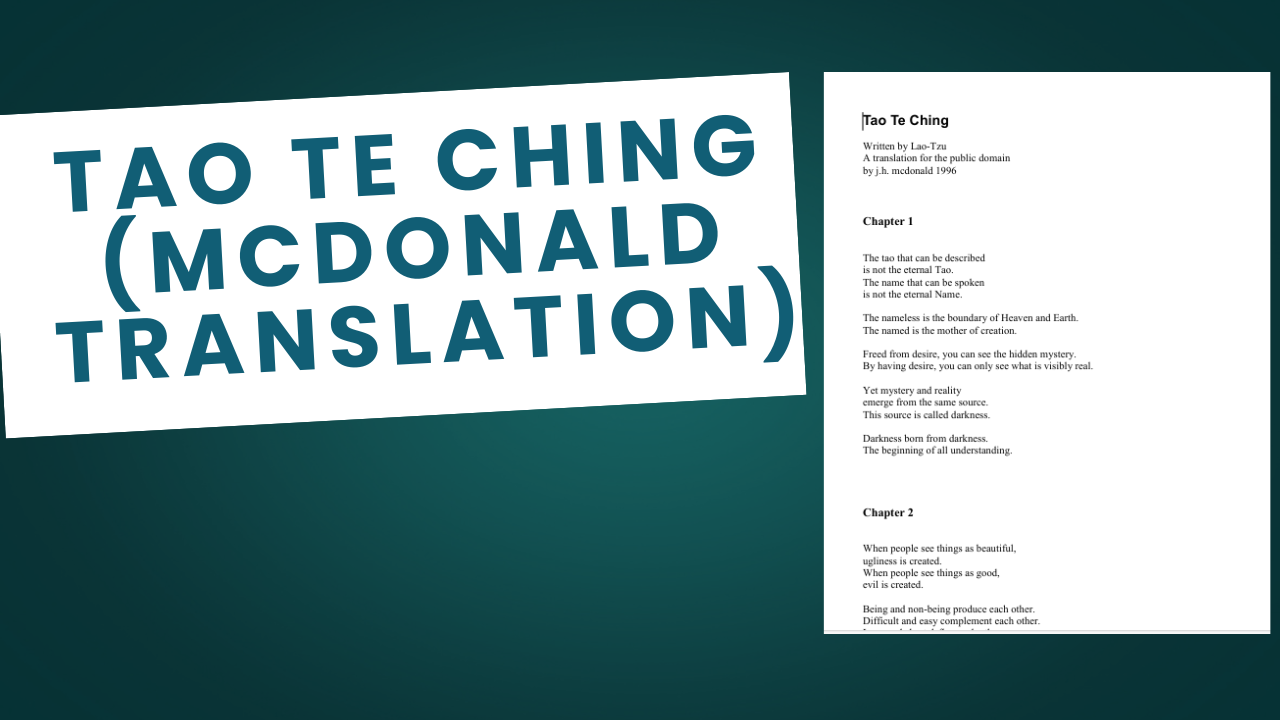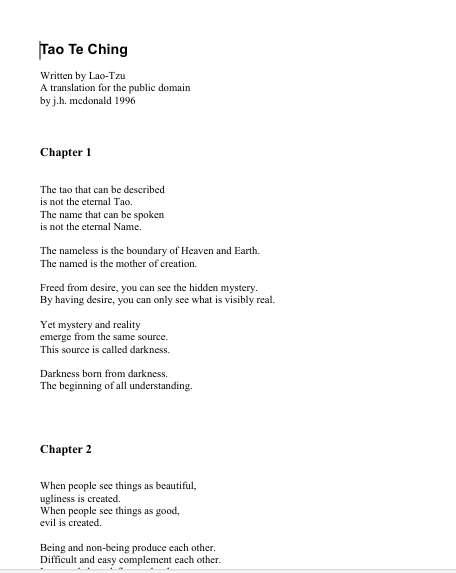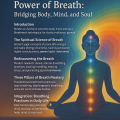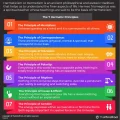
This text presents the Tao Te Ching, attributed to Lao-Tzu, offering wisdom on living in harmony with the Tao, often translated as “the Way.” It emphasizes principles like non-action (wu-wei), simplicity, humility, and understanding the interconnectedness of all things. The chapters explore the nature of the Tao as an indefinable source, advocate for a virtuous and selfless leadership, and caution against the pitfalls of desire, competition, and excessive control. Ultimately, the text guides towards a life of balance and inner peace by aligning with the natural flow of the universe.

Frequently Asked Questions on the Tao Te Ching
- What is the Tao, and why is it so difficult to define?
- The Tao, as described in the Tao Te Ching, is the fundamental principle underlying reality. It’s the source of all things, the way of the universe, and the natural order. However, the Tao that can be described is not the eternal Tao, because as soon as we attempt to define it with language, we limit it. The Tao is beyond words, and its true essence can only be grasped through direct experience and intuition, not intellectual understanding.
- What is “Wu-Wei” (non-action), and how does it relate to living in accordance with the Tao?
- Wu-Wei, often translated as “non-action” or “effortless action,” is a central concept. It doesn’t mean doing nothing, but rather acting in accordance with nature and allowing things to unfold naturally. It involves aligning oneself with the Tao and acting without force, resistance, or excessive intervention. By practicing Wu-Wei, one can achieve great things without striving or struggling, as the universe itself supports the action.
- Why does the Tao Te Ching emphasize simplicity, emptiness, and detachment from desires?
- The Tao Te Ching advocates simplicity, emptiness, and detachment from desires because these qualities allow one to connect more deeply with the Tao and live in harmony with the universe. Desires and attachments create suffering and cloud our perception of reality. By embracing simplicity and emptying the mind, we can become more receptive to the Tao’s wisdom and find true contentment. Emptiness allows for potential and receptivity, essential for growth and understanding.
- How does the concept of duality (e.g., good/evil, beauty/ugliness) play a role in the Tao Te Ching, and how should we relate to it?
- Duality is a fundamental aspect of the manifested world, as things like good and evil, beauty and ugliness, arise in relation to each other. The Tao Te Ching highlights the interconnectedness and interdependence of these opposites. Rather than rigidly clinging to one side of a duality, the Taoist sage recognizes the inherent unity underlying them and seeks balance. This understanding promotes acceptance and non-judgment.
- What is the role of a leader or ruler according to the Tao Te Ching?
- The Tao Te Ching suggests that the best leader is one who governs with minimal intervention, allowing people to live freely and naturally. The ideal leader leads by example, embodying virtues such as humility, compassion, and non-interference. Such a leader inspires trust and allows people to feel self-sufficient, as they are scarcely aware of the leader’s existence. The worst leader is one who is feared and despised.
- How does the Tao Te Ching view knowledge, wisdom, and learning?
- While not dismissing knowledge entirely, the Tao Te Ching cautions against over-reliance on intellectual pursuits. It suggests that true wisdom comes from inner understanding and direct experience, rather than the accumulation of facts and information. Too much intellectualism can lead to hypocrisy and a loss of connection with the Tao. Unlearning and simplifying are sometimes more valuable than constantly seeking new knowledge.
- What does the Tao Te Ching say about war, violence, and conflict?
- The Tao Te Ching views war and violence as undesirable and to be avoided whenever possible. Weapons are described as “bearers of bad news,” and victory in war is not a cause for celebration. The text emphasizes that using force always leads to unseen troubles. The ideal is to resolve conflicts through diplomacy, understanding, and compassion, rather than resorting to aggression. Even in necessary defense, sorrow for the loss of life is paramount.
- What is the ultimate goal or state of being that the Tao Te Ching encourages individuals to strive for?
- The ultimate goal in the Tao Te Ching is to achieve harmony with the Tao, which leads to a state of inner peace, fulfillment, and enlightenment. This involves cultivating virtues such as humility, compassion, simplicity, and non-action. By aligning oneself with the Tao, one can transcend the limitations of the ego, live authentically, and experience the interconnectedness of all things. Ultimately, the goal is to return to the source, the undifferentiated unity of the Tao.
A Study Guide to the Tao Te Ching
Quiz: Short Answer Questions
- According to Chapter 1, what is the difference between the “named” and the “nameless”?
- In Chapter 2, the text states that “Being and non-being produce each other.” Explain what this means using an example from the chapter.
- What does it mean to “act without doing anything” as mentioned in Chapter 2?
- According to Chapter 5, how does Heaven and Earth treat all of creation? How does the Master treat everyone?
- What is the significance of emptiness in Chapters 6 and 11, and how does it contribute to understanding the Tao?
- Explain the metaphor of water in Chapter 8 and how it relates to the Tao.
- According to Chapter 13, why is “success as dangerous as failure?”
- What does Chapter 16 suggest is the key to accepting things as they are, and what are the consequences of not knowing the “constant”?
- In Chapter 17, what are the qualities of the best leaders, and what is the mark of the worst?
- According to Chapter 40, what is born from substance, and what is born from nothing-ness?
Quiz: Answer Key
- The “nameless” is the boundary of Heaven and Earth, representing the origin and potentiality before creation. The “named” is the mother of creation, representing the manifested world with definable characteristics.
- This means that opposing forces are interdependent and define each other. For example, the concept of “beautiful” cannot exist without the concept of “ugliness,” as one defines the other.
- To “act without doing anything” means to act in accordance with the Tao, allowing things to happen naturally without forcing or interfering. The Master guides and facilitates without overt manipulation.
- Heaven and Earth treat all of creation as “straw dogs,” meaning they are impartial and do not show favoritism. Similarly, the Master treats everyone like a straw dog, impartially guiding all.
- Emptiness is essential because it allows for potential and utility. In Chapter 6 it creates Heaven and Earth, and in Chapter 11 emptiness gives the wheel, pot, and house their usefulness.
- Water benefits all of creation without competing and gathers in unpopular places. This mirrors the Tao’s humility and universal benefit without seeking recognition.
- Success is as dangerous as failure because both receiving favor and losing it cause alarm. Furthermore, it emphasizes that holding onto “self” creates vulnerability and enemies.
- Knowing the “constant” is the key to accepting things as they are, which leads to impartiality and unity with Heaven and the Tao. Not knowing the constant leads to evil deeds and being without roots.
- The best leaders are those who the people hardly know exist, who value their words, and accomplish their task, so the people say, “Amazing, we did it all by ourselves.” The worst ones are those who are despised.
- All of creation is born from substance. Substance is born from nothing-ness.
Essay Questions
- Discuss the concept of “wu-wei” (non-action) in the Tao Te Ching. How is it described, and what are its implications for personal and political life? Provide specific examples from the text to support your answer.
- Explore the Tao Te Ching‘s view of leadership. What qualities make a good leader, and how should a leader interact with their people? Contrast this with the qualities of a poor leader, providing textual examples to illustrate your points.
- Analyze the use of metaphors and analogies in the Tao Te Ching. Select three significant metaphors (e.g., water, the uncarved block, emptiness) and explain how they illuminate core concepts of Taoist philosophy.
- Examine the Tao Te Ching‘s perspective on knowledge and desire. How does the text view the pursuit of knowledge, and what are the potential pitfalls of excessive desire? Discuss how these ideas relate to the Taoist ideal of simplicity and harmony.
- Discuss the concept of returning to the source as described in the Tao Te Ching. What does it mean to return to the source, and how does one achieve it? How does understanding this concept affect one’s relationship with life, death, and the Tao?
Glossary of Key Terms
- Tao: (Often translated as “the Way”) The fundamental principle of the universe; the source of all existence; the natural order of things. It is often described as ineffable and beyond human comprehension.
- Te: (Often translated as “virtue” or “power”) The manifestation of the Tao in individual things; the inherent character or potential of something.
- Wu-wei: (Often translated as “non-action” or “effortless action”) Acting in accordance with the Tao; allowing things to happen naturally without forcing or interfering.
- Yin and Yang: Complementary opposites that exist in all things; Yin is often associated with darkness, passivity, and the feminine, while Yang is associated with light, activity, and the masculine.
- The Uncarved Block (Pu): A metaphor for the original, uncorrupted state of being; simplicity and naturalness before the influence of culture and desire.
- The Master/Sage: An individual who has attained enlightenment and lives in accordance with the Tao; a model for others to follow.
- Emptiness: A state of openness and receptivity; the absence of preconceived notions and desires, allowing the Tao to flow freely.
- Darkness: Often used to describe the mysterious and unfathomable nature of the Tao; not necessarily negative, but rather a place of potential and origin.
- Returning to the Source: The process of aligning oneself with the Tao; stripping away artificiality and returning to one’s natural state.
- Heaven: Not a personal god, but rather a representation of the natural order and cosmic forces that govern the universe.


















0 responses on "Tao Te Ching (McDonald Translation)"